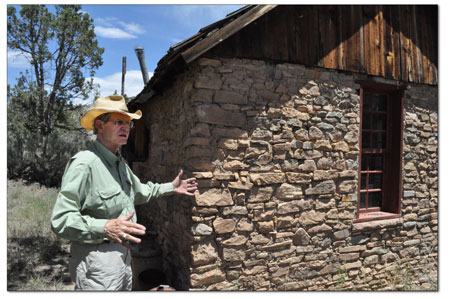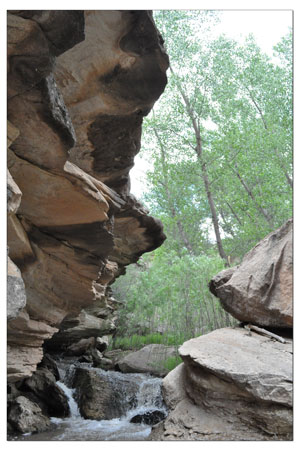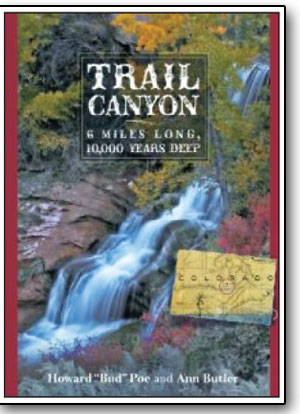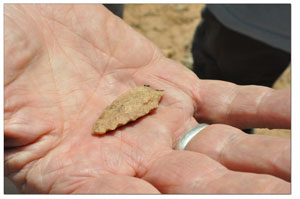 |
|
Howard “Bud” Poe talks about the Rock House in Trail Canyon, a 200-square-foot homesteaders cabin and birthplace of Harold Baxstrom, one of the voices behind the book./Photos by Scott Wachob |
Tales from the Trail
Western history comes alive in the ‘rollicking yarns’ of Trail Canyon
by Tracy Chamberlin
It might have been the eggs. Or, maybe it was the green chilies. Either way it all began over breakfast.
It might have been the eggs. Or, maybe it was the green chilies. Either way it all began over breakfast.
Howard “Bud” Poe had a hashbrown pancake covered in green chilies, cheese, eggs and salsa called the Mex Brex. Gary Matlock ordered the simple scrambled eggs with a side of hashbrowns.
And, as the two men shared that morning meal at Oscar’s they talked about a long, narrow valley about 5 miles west of Cortez called Trail Canyon. Matlock told Poe stories of working on the cattle ranch in that valley decades earlier and of the long history of peoples that left their mark on the land.
Little did they know that during those breakfasts, they were actually starting to write another story. One that would shape not only that 6-mile canyon’s future, but their own as well.
The two first met when Matlock, an archeologist, hosted a historical presentation on Trail Canyon and one of its most famous landmarks, Rock House. Matlock provided a pamphlet for the event describing some of the history of the canyon’s earliest inhabitants, Paleo-Indian peoples and Ancestral Puebloans.
One thing the pamphlet didn’t include was a detailed history of the more recent occupants, including the homesteaders who built Rock House and called it home. The 200-square-foot building was witness to births, lives and later added to the Colorado Historical Register in 2006. Poe wanted to know even more about the Rock House and Trail Canyon, so he asked Matlock to join him for breakfast.
The pamphlet that originally intrigued Poe was also the impetus behind the book, Trail Canyon: 6 Miles Long, 10,000 Years Deep, authored by Poe and local writer Ann Butler.
It’s a collection of tales, histories, poetry and peoples who called the canyon home from 8,000 B.C. to the present.
Poe is like the conductor to this symphony of stories, which are emblematic of the history of the West and host to a cast of characters ranging from the Anasazi and Spanish explorers to the first homesteaders and modern conservationists.
Chronicling the canyon and all these characters eventually grew from a two-man task into a four-person adventure. Affectionately dubbed “The Odd Quad,” this diverse group, which included Matlock, Poe, Harold Baxstrom and Mary Jane Schott, brought their own stories and perspectives to the project and became the voices behind the book.
From the Outlaw Cave and Murder Ridge Road to Rock House and the epic battle between a trout and a mouse, Trail Canyon is full of these entertaining tales from the Trail that Poe called “rollicking good yarns.”
 |
| Formerly called Trail Gulch, the 6-mile valley features a diverse landscape including cascading waters that flow into into McElmo Creek and eventually the Colorado River./Photos by Scott Wachob |
Several of the stories are about how the beauty and wonder of the valley was never handed out to any of its occupants. It was earned.
Matlock’s family had been a part of the canyon since 1939. His uncle owned Trail Canyon Ranch, where Matlock worked during the summers of his youth. Poe said he called the canyon “Shangri-La.”
When Matlock’s uncle first surveyed the land with his family, the canyon presented them with a firm reminder of who was in charge.
His cousin notes in the book that “a huge rock rolled down the cliff and right into the yard. No one or no thing was hurt, but the speed, power and noise pronounced the canyon itself as the determiner of activities within its walls.”
Trail Canyon would let the family prosper and enjoy life, she continued, but only on its terms. And, it treated everyone that way, including Puebloans, homesteaders and, of course, Poe.
When he entered the picture in 1997, the canyon spoke again with a loud bang. Soon after moving into the area, a boulder came thundering down a cliff wall, just as it had all those decades before.
This time the boulder landed squarely on the road leading in and out of the area. Not until “some serious machinery” and a little bit of dynamite intervened, could things get moving again. According to Poe’s account in the book, “the canyon wanted to make sure the new occupants knew who was boss.”
One of Poe’s favorite yarns is about his chance encounter with Bessie. He’d been working all day cleaning out irrigation ditches and was finally headed home for dinner. With the sun low in the sky 4 and the cottonwoods glowing in that late afternoon light, he stopped the car and got out to enjoy the moment.
That’s when he noticed her. Bessie the cow was stuck between two fallen cottonwoods in a nearby embankment, and by the looks of it had been trying to get free for some time. As Poe puts it, she had gotten herself into quite a pickle.

Using a strong log, he pried the cottonwoods apart freeing Bessie and rescuing the fair maiden who trudged back to her herd. But it left him wondering, “What was it that really made me stop?”
Like his meeting with Bessie or breakfasts with Matlock, many of Poe’s Trail Canyon moments are reminders of serendipitous interventions into the life of Trail Canyon.
Throughout the 15 years that Poe was heavily involved with the area, he worked with private landowners, government agencies, lawyers, local officials and countless others to preserve and protect both the history and land.
It was a 1,000-piece puzzle that came together naturally, but with plenty of yarns to spin along the way.
After spending so much time on the property, he knows that long, narrow valley well. So although Poe no longer lives in Trail Canyon, his priority is still preservation. He also continues to host talks and presentations on the canyon, as well as book-signings and the occasional tour.
With already about 4 miles in conservation easement, he said he feels the “right people” are on board to keep the legacy of that land alive.
Poe said the process has changed him, teaching him to go by his heart and not always his head.

And when asked why he put so much time and energy into this particular piece of the West, he pointed to a Native American proverb in the book. “Treat the earth well: It was not given to you by your parents, it was loaned to you by your children.”
In this week's issue...
- September 11, 2025
- Back on top
After harrowing flying accident, local highliner steps back out with renewed mission
- September 11, 2025
- New order
Rule change for Land and Water Conservation Fund raises alarms
- September 4, 2025
- Armed with knowledge
Local community organizers work to ensure immigrant neighbors know their rights
